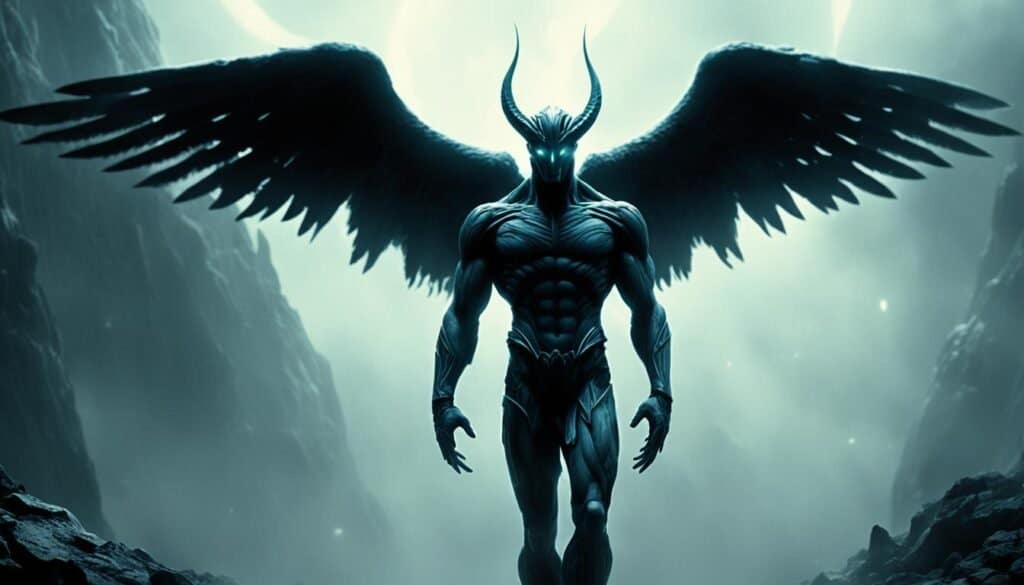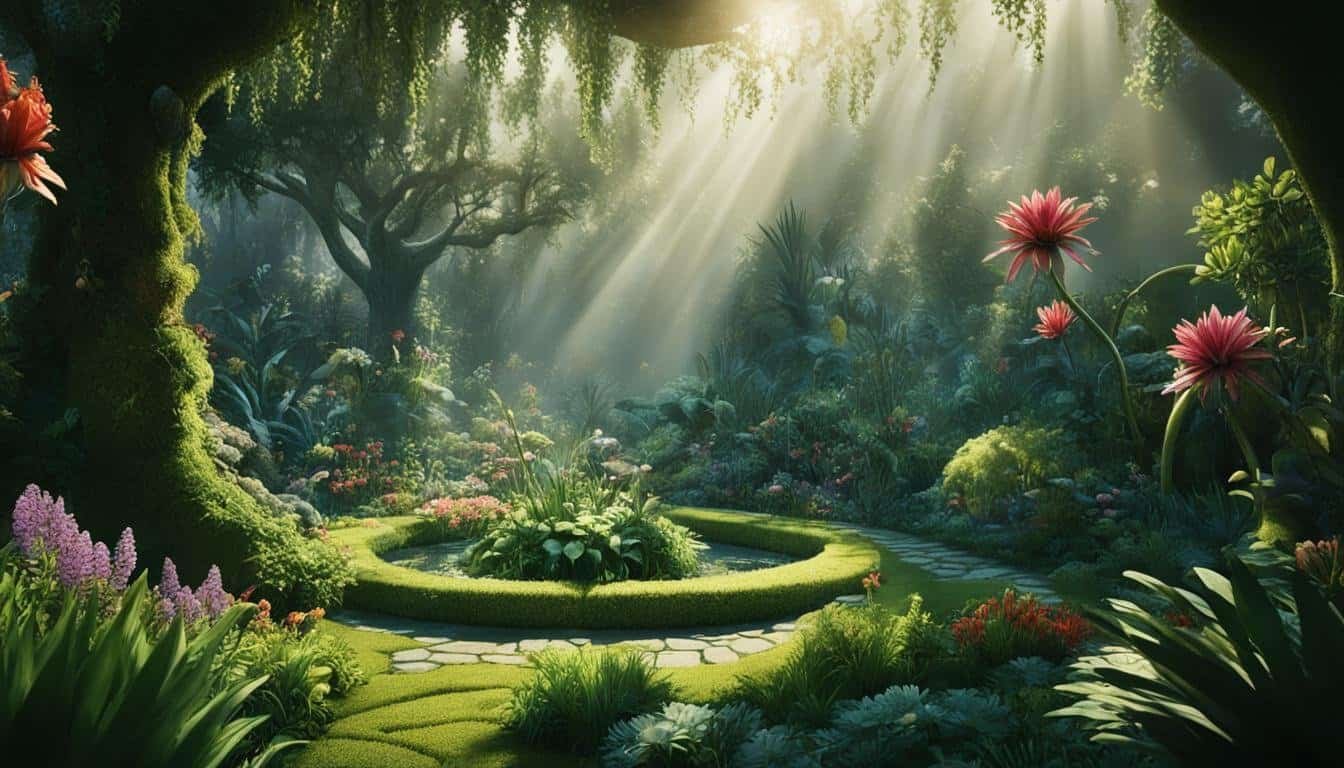Welcome to a captivating journey through Genesis. This article uncovers ten mysteries and ambiguities that still puzzle us. We’ll explore the length of creation days and the secrets of the Garden of Eden. These questions are both challenging and fascinating, inviting us to think deeply about ancient enigmas. Are you ready to discover more?
Key Takeaways:
- Genesis presents numerous mysteries and ambiguities that leave readers with unanswered questions.
- The duration of the creation days and the location of the Garden of Eden are two perplexing riddles.
- Other mysteries include the nature of the “Nephilim” and the details of the flood.
- Genesis also leaves us wondering about the significance of the rainbow’s covenant and the ages of the antediluvian patriarchs.
- Lastly, the dispersion of peoples and the mysterious “garden east of Eden” intrigue our imagination.
The Length of the Creative Days
The Bible’s book of Genesis holds a mystery about the days of creation. It talks about six “days” of creation. Yet, it doesn’t clearly say if these are literal 24-hour periods or longer, undefined times.
The debate around the length of these creative days has lasted centuries. Some think the days were literal and followed a 24-hour clock. Others believe they symbolize bigger, undefined periods, matching vast stretches of time or even eras.
To really understand these different thoughts, let’s look at the reasons behind each side:
Literal 24-hour periods:
- Biblical consistency: Those who take this view say it’s vital to understand Genesis literally. They believe turning the days into symbols might weaken the Bible’s truth.
- Sequential order: They also note a clear, step-by-step order in the creation story, which suggests literal, short days.
- Contextual clues: Backers often point to Bible sections like the fourth commandment’s mention of the seven-day structure. They say this links back to creation’s days being literal.
Vast stretches of time:
- Scientific compatibility: Others look at the big picture, trying to mix the Bible with scientific facts. For them, seeing the “days” as longer makes holy scripture fit with what we know about the Earth and how it formed.
- Theological symbolism: They suggest there’s a deep, symbolic meaning in each day as a different stage in God’s creative process. This makes each “day” a significant chapter in the story of creation.
- Flexible language: These believers say the Hebrew text’s word for “day,” “yom,” is flexible. Translating it as “day” might not always mean a strict 24-hour period. They think Genesis hints at broader time frames.
“The question of whether the creation days are literal 24-hour periods or vast stretches of time remains a fascinating and ongoing discussion within religious and academic circles. Ultimately, the interpretation of the creative days in Genesis reflects our attempts to comprehend the mysteries of the divine and the complexities of the universe.”
Though the exact length of these creative days is still unclear, looking at these varied ideas helps us understand the Bible better. It shows us the awe-inspiring power of God’s creation regardless of how we view these days. Genesis is an incredible story about the beginning of our world.
The Garden of Eden’s Location
In Genesis, we read about the Garden of Eden and its relation to the Tigris and Euphrates rivers. These rivers are famous and help us think about where this garden might have been. They give us clues about its possible location in the world before a great flood.
The Tigris and Euphrates, in what is now Iraq, are said to be the rivers from Genesis. They are close and connect to Mesopotamia, an ancient civilization’s birthplace. Because of this, many think the Garden of Eden might have been there.
But finding exactly where the Garden of Eden was is hard. A big flood, as told in Genesis, may have changed the land a lot. This makes it tough to know for sure where the garden was.
As we look into where the Garden of Eden might have been, we should remember it was a long time ago. The big flood changed the world and made it hard to find old landmarks.
Others suggest different places for the Garden of Eden, like the area around the Persian Gulf or ancient cities in Mesopotamia, such as Eridu. They look at things like old texts and the land to guess where this lost paradise could be.
Even though we may never find the exact spot, the story of the Garden of Eden is still important. It reminds us of our connection to nature, the start of humanity, and the big questions that make us think and dream.
Now, let’s learn more about the Tigris and Euphrates rivers and their role in the ancient world, before the great flood.
The Tigris and Euphrates Rivers
The Tigris and Euphrates start in the Armenian Highlands and flow through parts of Turkey, Iraq, and Iran. They were very important for ancient civilizations because they provided land for farming, a way to move goods, and fresh water.
They were key for the Sumerians, Babylonians, and Assyrians, helping their empires grow. These rivers also shaped the living spaces and cultures of people in the ancient Near East.
Thinking about the Garden of Eden with these rivers makes a connection. It links the idea of a perfect place to the real places of ancient Mesopotamia.
Even though we don’t know the exact spot of the Garden of Eden, the Tigris and Euphrates rivers show us how myths and real places can come together. They make us think about where we come from and what our story means.
The “Nephilim”
The book of Genesis tells us about the Nephilim. They are a mysterious group said to be offspring of heavenly and earthly beings. These beings, known before the great flood, are shrouded in mystery, leading to various viewpoints.
Genesis doesn’t clearly say who or what the Nephilim were. Their appearance has kindled debates among those who study the Bible. These debates include scholars, theologians, and curious readers.
Some people think the Nephilim were actual giants or semi-divine creatures. They believe they were born from a forbidden mixing of celestial and mortal beings. Others see them as symbols of a time when moral decay was widespread.
Genesis may not clarify the nature of the Nephilim, yet their story is intriguing. It prompts interesting queries about the division between divine and human spheres. Additionally, it raises thoughts on the consequences of such forbidden connections.
The Nephilim, born of a celestial and mortal union, are a key enigma in Genesis. They inspire us to explore the profound mysteries in the Bible. This exploration leads to a deeper understanding of how the heavenly and earthly realms interact.
The Nephilim continue to intrigue us centuries later. They focus our attention on understanding biblical stories in more depth. Exploring these tales broadens our understanding of the human experience and spiritual matters. It encourages us to accept the mysteries within Genesis.

The Fall of Humanity’s Language
The Tower of Babel tale in Genesis explains how humanity acquired different languages. The story tells how people aimed to build a tower to heaven against God’s will. They wanted to make a name for themselves and avoid being spread over the earth.
God responded to their arrogance and disobedience by confusing their language. He then scattered them worldwide. This action caused the birth of various languages, complicating communication between far-off peoples. The Tower of Babel marks a crucial point in history where one language turned into many.
Genesis doesn’t explain the first universal language or how languages diversified. It sparks our interest in the variety of languages around us, each with its beauty and complexity.
The Tower of Babel story teaches us about the pros and cons of language. It shows how language can unite us but also divide us. This tale underlines the need to value and understand different languages, promoting harmony among diverse cultures.
The Nature of the Serpent
The story of the Garden of Eden highlights the mysterious serpent. In Genesis, it tempts Eve to eat the forbidden fruit, which brings humanity’s Fall. The debate whether the serpent was real or a symbol of evil is ongoing.
Some people think the serpent was just a real animal. They say it acted on behalf of evil forces to bring about the Fall.
Others see the serpent as a symbol of evil. They believe it wasn’t a real snake but a symbol for the concept of temptation and evil in the world.
This view fits with many beliefs across various cultures and religions. For them, serpents stand for deceit, trickery, and evil.
“The serpent, a creature of cunning and deception, has long been seen as a symbol of evil in many cultures.”
Exploring the serpent in the Eden story encourages an open perspective. Whether real or symbolic of evil, it reminds us of humanity’s choices and their outcomes.
Intriguing Questions to Consider:
- Do you believe the serpent was a literal animal or a symbolic representation of evil?
- How does your interpretation of the serpent’s nature change how you see the story?
- What do you think the serpent teaches us about good and evil?

| Literal Animal | Symbolic Representation of Evil |
|---|---|
| Portrayed as a physical creature that facilitated the Fall | Seen as a metaphorical figure representing temptation and the presence of evil |
| Aligns with a more literal interpretation of biblical stories | Reflects a more abstract understanding of the forces of good and evil |
| Emphasizes the physicality and reality of the serpent’s presence | Highlights the moral and spiritual implications associated with the serpent’s role |
The Details of the Flood
Genesis tells of a massive flood. It’s unclear how all animals fit on the ark. Many details, like water coverage and animal housing, are mysteries.
“God told Noah to build an ark from gopher wood. Noah should make rooms, put pitch inside and out. Its size should be 300 cubits long, 50 cubits wide, and 30 cubits high.” (Genesis 6:14-15)
The bible gives the ark’s size but not animal logistics. It shows limited space but not how this worked out.
There’s debate over the flood’s reach. Was it global or local? The exact details about the floodwaters are still up for discussion.

The flood story shows God’s judgment and mercy. It warns about disobeying God. But, it also shows the blessings of obeying Him.
The Rainbow’s Covenant
When the flood in Noah’s time covered the earth, God made a promise. He vowed to never flood the planet again. The rainbow we see now is a sign of this promise. Genesis tells us about this, but not all the details.
This rainbow is more than its pretty colors. It’s a constant reminder of God’s pledge. It says the promise is for always. It’s like a symbol of a strong, unbreakable bond.
“I have set my rainbow in the clouds, and it will be the sign of the covenant between me and the earth.” – Genesis 9:13
Rainbows are not just pretty; they’re magical. They make us think of the wonders around us. When the rain stops and the sun comes out, that rainbow appears. It’s then that we remember God’s promise to Noah and the world.

Looking at a rainbow gives us peace. It tells us God’s love and mercy is forever. Even in tough times, a rainbow promises better days ahead. It’s a beautiful, hopeful reminder from God.
| Symbolism | Significance |
|---|---|
| The Rainbow | God’s covenant with Noah and all generations |
| Vibrant Colors | The everlasting nature of the covenant |
| Beauty and Majesty | The sacred bond of trust and protection |
The Ages of the Antediluvian Patriarchs
Genesis shares a puzzling mystery: the ages of people like Adam and Methuselah. They are said to have lived for hundreds or thousands of years. This has led to a lot of talk and thinking among experts.
Some believe these long lifespans are true facts. They say these people really did live such long lives. This view makes us wonder about the world before the big flood. What was different then?
“And all the days of Methuselah were nine hundred sixty and nine years: and he died.” – Genesis 5:27
Others think these ages are symbols, not meant to be taken literally. They talk about wisdom, God’s favor, and how mankind’s condition changed. This is after Adam and Eve’s mistake, according to the Bible.
No matter the view, these ages remind us of the awe and wonder in the Bible. They make us think about life’s long span and the deep messages in the book.
Symbolic Representation of Extraordinary Lifespans
Looking at these ages symbolically helps us see deeper into the Bible’s messages. It’s not just about the numbers. It’s about what the numbers symbolize.
“And Adam lived an hundred and thirty years, and begat a son in his own likeness, after his image; and called his name Seth.” – Genesis 5:3
These long lifespans might show spiritual things or the bond between people and God then. A theory is that they show how close people were to God, getting wiser each year. Another is that the ages getting shorter after the flood show how humanity’s spirituality weakened.
The exact meaning can change based on how you see it. Yet, the ages of these people are key in the Bible. They take us back to a time full of mysteries. They urge us to find the deeper truths in the text.
Exploring the Significance
The long lives in the Bible give us a chance to think deeply. They suggest many profound ideas. Like what life, faith, and the link between people and God might mean.
Thinking about whether these ages are real or symbols makes us ponder faith and the Bible’s purpose. The riddle of the Bible’s ancient ages keeps us spellbound. It highlights the timeless power and importance of these tales.
The Dispersion of Peoples
After the flood, people began to move to different places. They spread out worldwide. This movement was a big step in how civilizations and cultures grew.
This spreading out really changed the world’s makeup. People’s movements led to new homes, familiarizing with unexplored lands, and mixing cultures and languages. As a result, our planet saw a boost in numbers and the start of various ethnic groups.
“The dispersion of peoples after the flood was a key factor in the human story. It represents the beginning of a new chapter in the history of civilization, as different groups embarked on their unique journeys, adapting to various environments and shaping their own destinies.” – Dr. John Andrews, Archaeologist
The Timeline and Legacy of Migration
Though Genesis talks about people spreading out, it misses the details. The how and when is a mystery that keeps experts wondering. This mystery intrigues historians, archaeologists, and anthropologists alike.
Moving to new places affected civilizations in places like Mesopotamia, Egypt, and the Americas. Such movements led to big empires, wider trade, and the sharing of ideas and technologies.
Exploring the Impact of Migration
Studying the movement of people gives us clues about our shared past. It shows how humans adapted to new places and cultures. It also highlights our shared strength and ability to overcome challenges.
This look at past migrations helps us understand our history better. It shows how the mix of cultures, languages, and traditions enriches our world. We can learn a lot from these ancient stories.
Migration and growing in number have shaped our societies deeply. By blending Genesis’ account with what we find through archaeology and history, we learn a lot. We realize the incredible stories of human adventure that have made the world as we know it.
What Ethical Dilemmas Arise from the Mysteries and Ambiguities in Genesis?
The complexities of Genesis present profound moral questions that resonate through time. As readers delve into narratives of creation, free will, and divine intervention, grappling with ethical challenges becomes inevitable. These stories compel individuals to reflect on responsibility, justice, and the nature of good versus evil within their own lives.
The “Garden East of Eden”
After being expelled from The Garden of Eden, Genesis tells of a “garden east of Eden.” This garden was guarded by cherubim to protect the tree of life. They make us wonder, reminding us of a lost paradise we wish we could see again but can’t.
It’s unknown where exactly this garden was. People guess if it was real or a symbol. But, the garden east of Eden symbolizes our search for a perfect place and time of harmony.
Cherubim protected the garden, stopping anyone from going back in. They show us the results of our choices. The garden teaches us about wanting something better than what we have and the search to fill that missing part of us.
Affiliate Disclosure: "As an Amazon Associate I earn from qualifying purchases made from links in this post. We are a participant in the Amazon Services LLC Associates Program, an affiliate advertising program designed to provide a means for us to earn fees by linking to Amazon.com."

